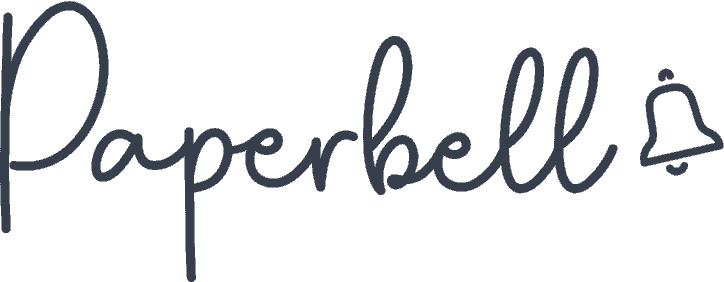The coaching industry has experienced a massive shift toward online and digital delivery. As such, video coaching has become an essential part of building a successful online coaching process.
But there are hundreds of options available, from basic video conferencing tools to sophisticated digital coaching platforms. So how do you know which solution will actually serve your business and your clients best?
In this guide, you’ll learn:
- Key features of video coaching platforms
- Types of video coaching platforms
- How to choose a solution that grows with your coaching business
What is a Video Coaching Platform?
A video coaching platform is a specialized software solution designed specifically for delivering coaching services through video technology. The best ones are designed both for individual coaching and group coaching.
Unlike general video conferencing tools that focus on basic virtual meetings, video coaching platforms are built with coaches in mind.
These platforms typically include features like:
- Automatic session recording
- Client progress tracking
- Secure file sharing
- Integration capabilities with other coaching business tools
The goal is to create a seamless experience for both coaches and clients throughout the entire coaching relationship.
Video Coaching Platforms vs General Video Conferencing Tools
The key difference between video coaching platforms and standard video conferencing tools lies in their purpose-built features for coaching relationships.
For instance, both Zoom and Google Meet can facilitate a coaching conversation. However, they don’t help you:
- Manage client progress
- Store session recordings in an organized way
- Integrate with your coaching business operations
The opposite is usually true, meaning that coaching tools will integrate with Zoom, not the other way around. For instance, Paperbell integrates with Zoom to create unique meeting links every time a client schedules a new meeting.
General video conferencing tools focus on facilitating meetings without the coaching-specific functionality that makes your practice more efficient.
Types of Video Coaching
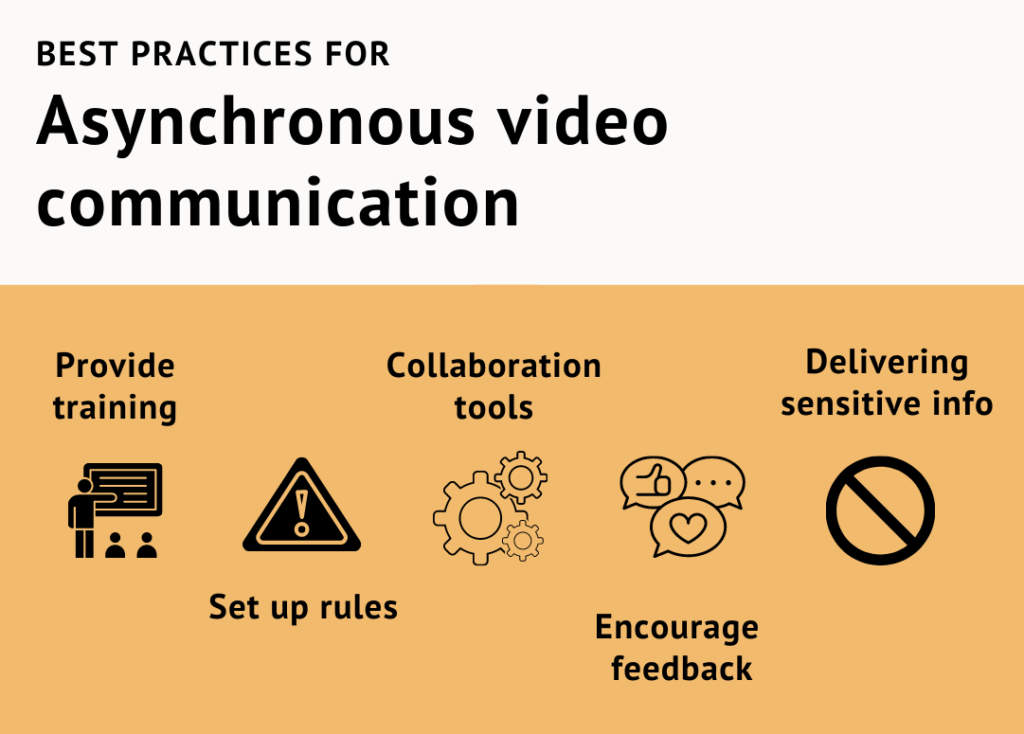
Video coaching can take several different forms depending on your coaching style and client needs:
- Live video coaching happens in real-time, just like an in-person session. You and your client connect via video call at a scheduled time. This format works well for accountability coaching, breakthrough sessions, and any coaching that benefits from immediate back-and-forth dialogue.
- Asynchronous video coaching allows clients to record video messages or complete video exercises on their own schedule. As a coach, you can respond with video feedback when it’s convenient for you. This approach is perfect for busy clients in different time zones or coaches who want to provide more flexible service delivery.
- Hybrid video coaching combines both live and asynchronous elements. You might have scheduled live sessions combined with ongoing video check-ins, recorded lesson delivery, or video-based homework assignments between sessions.
Key Features of a Video Coaching Platform
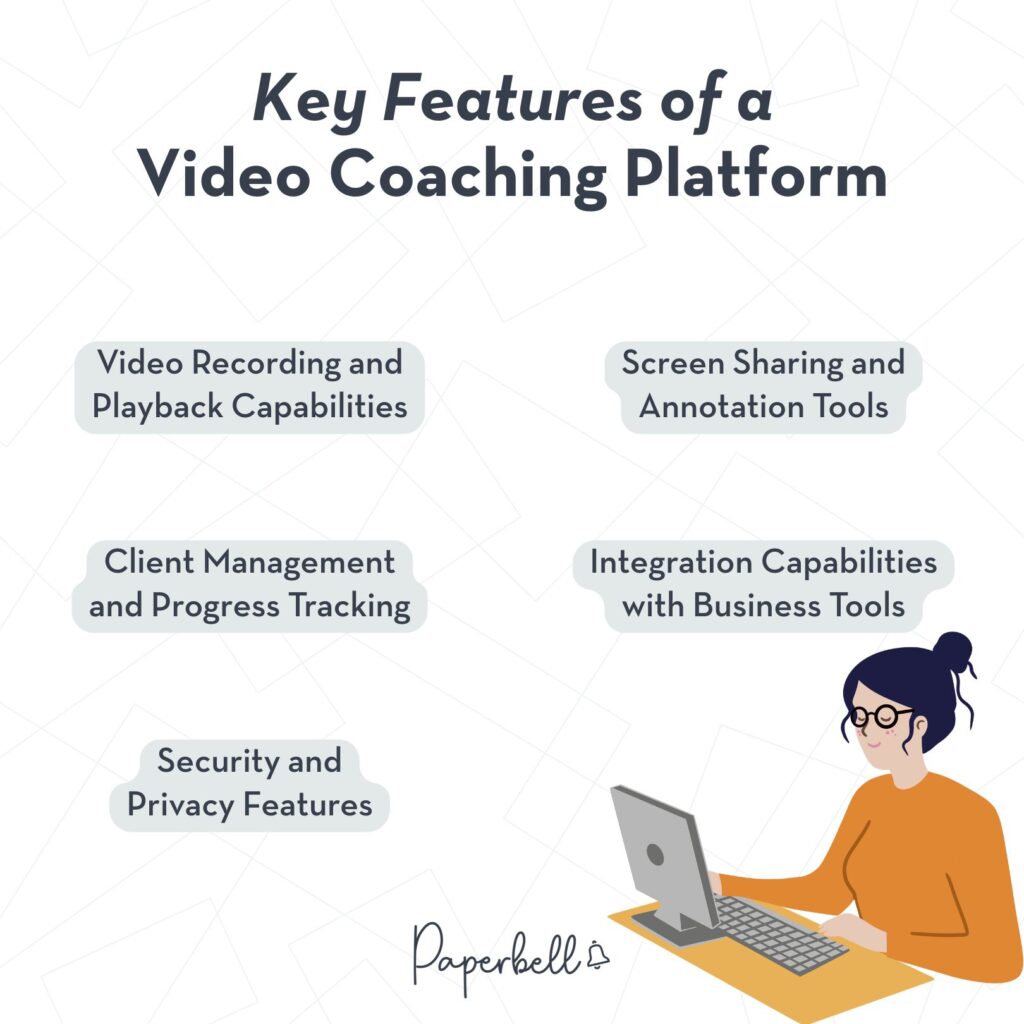
Certain features of video coaching platforms can significantly impact your ability to deliver effective coaching and run a smooth business operation.
Let’s cover some of those most important features.
Video Recording and Playback Capabilities
Video recording and playback capabilities are non-negotiable for coaching. Many coaches find that recorded sessions help clients review key insights and breakthroughs from their coaching conversations.
Playback also allows both you and your client to fully focus on your conversation while it’s happening, instead of trying to take extensive notes.
Some platforms automatically record and organize sessions by client. Others require a manual recording setup.
Screen Sharing and Annotation Tools
Screen sharing and annotation tools become crucial if your coaching involves:
- Reviewing documents
- Walking through coaching exercises
- Collaborating on visual materials
Look for platforms that allow both you and your clients to share screens and make annotations during sessions.
Client Management and Progress Tracking
Client management and progress tracking features help you maintain detailed records of each client’s journey.
The best coaching software includes:
- Note-taking capabilities
- Progress tracking tools
- The ability to set goals and milestones that you can reference across multiple sessions
Just like video playback features, automatic note-taking removes the burden from both the coach and client during the actual session.
Integration Capabilities with Business Tools
Integration capabilities determine how well your video platform works with your existing business tools. If you’re using specific tools such as:
- Coaching management software
- Scheduling tools
- Payment processors
You’ll want a video platform that connects seamlessly with your current setup.
Security and Privacy Features
Security and privacy features are important when working with coaching clients who are putting their trust in you. But in some coaching niches, like health and wellness, they’re non-negotiable.
Look for platforms that offer:
- End-to-end encryption
- Secure file storage
- Compliance with relevant privacy regulations
Many coaches work with clients on sensitive personal or professional topics. That data isn’t to be taken lightly.
Types of Video Coaching Platforms
Let’s go over the different categories of video coaching platforms to help you narrow down your options based on your specific needs and budget.
General Video Conferencing Tools
General video conferencing tools like Zoom, Google Meet, and Microsoft Teams weren’t designed specifically for coaching. Yet, many coaches use them successfully.
That’s because these platforms excel at reliable video connections and basic screen sharing. With that being said, they lack coaching-specific features like client management or progress tracking.
The main advantage of general video conferencing tools is their familiarity and affordability. Most clients already know how to use Zoom, which reduces the learning curve.
However, you’ll need separate tools for:
- Scheduling
- Client management
- Session organization
Pro tip: If you already use general video conferencing tools, you’ll love Paperbell. Try it for free to automate the back-end of your coaching business and integrate with your favorite video tools.
All-in-One Coaching Platforms with Video Features
All-in-one coaching platforms with video features combine video capabilities with comprehensive business management tools.
These platforms typically include:
- Scheduling
- Payment processing
- Client portals
- Video delivery
And much more, all in one place.
This approach can simplify your tech stack and create a more cohesive client experience.
Specialized Video Analysis Platforms
Specialized video analysis platforms cater to coaches who work with performance improvement, such as:
- Sports coaches
- Public speaking coaches
- Skill development coaches
These platforms often include features like slow-motion playback, game day photos & stills, video annotation, and detailed analysis tools.
Video Conferencing Tools Adapted for Coaching
Video conferencing tools adapted for coaching sit somewhere between general conferencing tools and specialized coaching platforms.
They typically add coaching-specific features like:
- Session recording
- Note-taking
- Basic client management
How to Choose a Video Coaching Platform
Selecting the right video coaching platform requires careful consideration of your unique coaching style, client needs, and business goals.
1. Assess Your Coaching Style and Client Needs.
Start by assessing your coaching style and client needs:
- Do you primarily deliver one-on-one coaching, group programs, or a combination of both?
- Do your clients need to access recorded sessions for review?
- Do you work with sensitive topics that require extra security measures?
For example, if you’re a life coach who focuses on breakthrough conversations, you might prioritize reliable video quality and session recording.
But if you’re a business coach who reviews documents and strategies with clients, screen sharing and annotation capabilities might be more important.
2. Consider Budget and ROI Analysis.
Budget considerations go beyond the monthly platform fee. Consider the total cost of ownership, including:
- Any setup fees
- Per-user charges (especially if you have a team)
- Storage costs
- Integration expenses
Also, think about the opportunity cost of using a platform that doesn’t integrate well with your other business tools.
Many free online coaching platforms offer basic video functionality, but they often come with limitations on recording storage, participant numbers, or session length.
As your coaching business grows, these limitations can become costly constraints that make scaling your business harder than it could be.
3. Evaluate Technical Requirements and Learning Curve.
Technical requirements and learning curve matter for both you and your clients. A platform with advanced features won’t help your business if it’s too complicated for your clients to use consistently.
Consider your own technical comfort level as well as your typical client demographic.
4. Plan for Scalability and Business Growth.
Scalability becomes crucial as your coaching business grows. The best video coaching platform for a solo coach just starting out might not work for someone running group coaching programs with dozens of participants.
Look for platforms that can accommodate your current needs while leaving room for growth.
5. Review Integration with Existing Tools.
Integration with existing tools can make or break your coaching workflow.
If you’re already using specific tools that you love, choose a video platform that works well with your current setup rather than forcing you to change everything.
How to Use Paperbell with Your Chosen Video Coaching Platform
My honest opinion? The best setup for coaches who want to go all in with video coaching, especially in a hybrid setup, is to pick a dedicated video platform and a separate coaching management software.
Why you need both a video platform and coaching management software comes down to specialization. Video platforms excel at delivering great video experiences, while coaching management platforms like Paperbell excel at running your coaching business.
Some tools exist that do both, but you’ll find they compromise on quality in at least one of these areas.
Paperbell handles the business side of your coaching practice, including:
- Client onboarding
- Package creation and sales
- Scheduling
- Payment processing
- Contract signing
- Client communication
- Video sharing (and other digital resources)
Your chosen video platform handles the actual session delivery. Together, they create a complete solution that serves both your business needs and your client experience.
Here’s how it works:
Inside Paperbell, navigate to your account settings by clicking on your profile picture in the top right corner. From there, choose Meeting Integration.
You’ll see a drop-down menu with a few options:
- Google Meet
- Zoom
- Custom URL
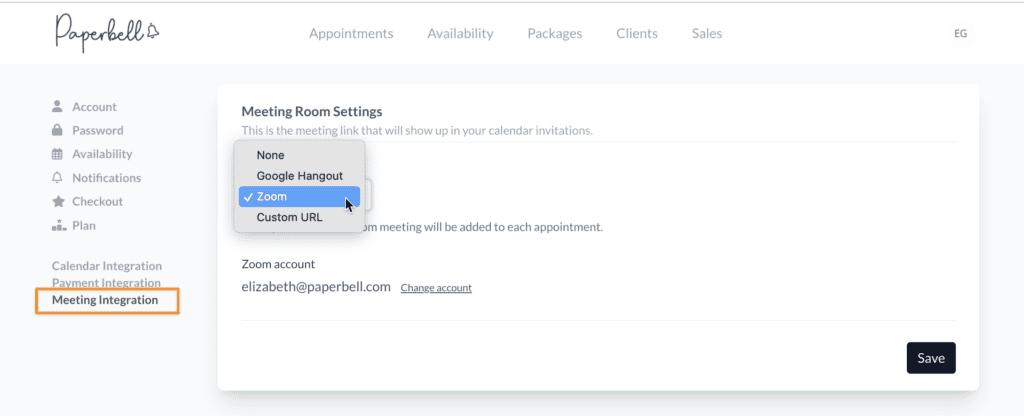
Let’s say you decide to pick Zoom. You’ll be prompted to connect your existing Zoom account.
From there, you’ll find your Zoom link in the calendar invite that’s automatically sent out to both your client and your connected calendar.
Alternatively, you can navigate to Appointments in Paperbell, click on the appointment, and check the meeting link.
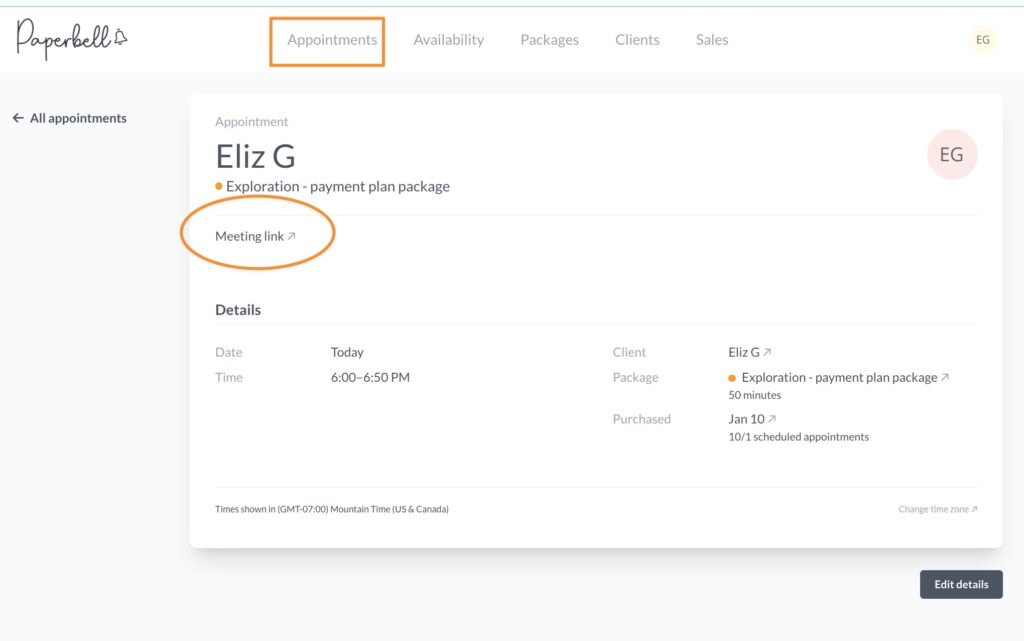
So, that’s how synchronous video coaching works, but what if you want to share session recordings or other video resources?
There are two ways to do this:
- Share a video with every client who purchases a specific coaching package, either immediately upon purchase or on a drip schedule; or
- Directly in a client’s private file
For Option 1, navigate to Packages and choose the Content tab on the left. You’ll be able to add videos (or other digital content) via this area.
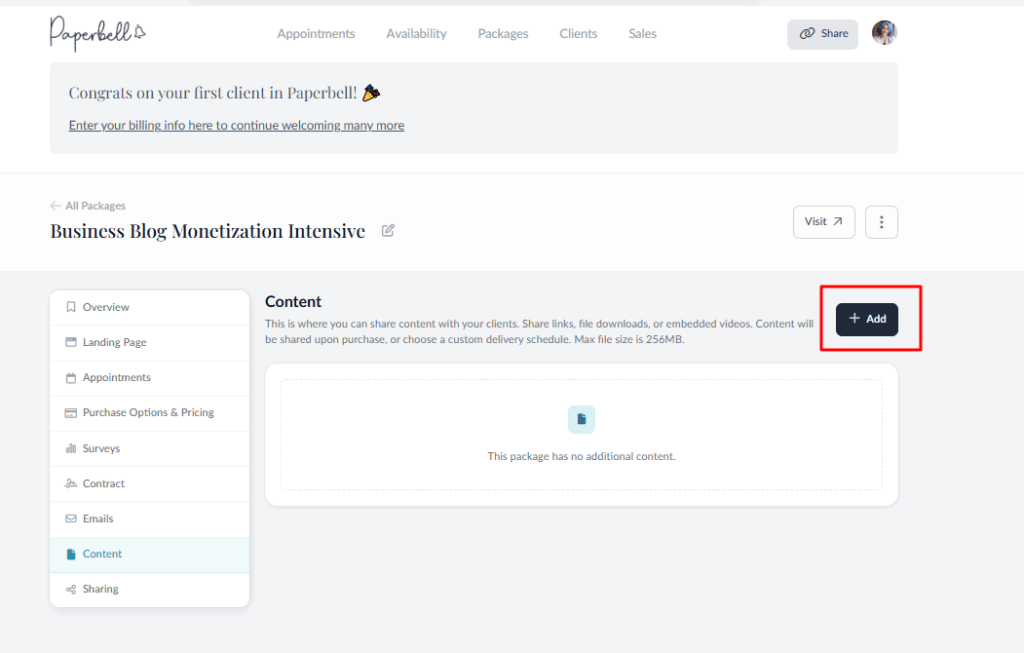
For Option 2, go to the Clients tab instead and click on the client with whom you want to share a video. Then, select the Private Content Tab.
This is where both you and your client can upload videos only accessible to the two of you.
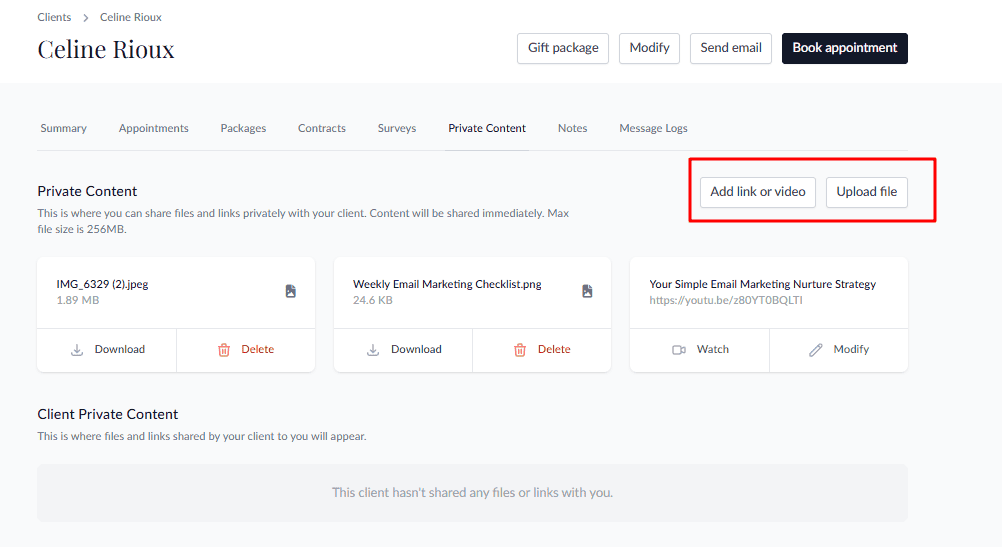
Integrating video coaching with client management becomes seamless when your video platform connects with your coaching management software.
Clients can:
- Book their sessions through your coaching platform
- Receive automatic calendar invites with video links
- Access session recordings and additional resources through their client portal
Streamlining scheduling and payments through integrations also eliminates double work and reduces the chance of scheduling conflicts or payment issues. When your video platform talks to your coaching management software, everything stays synchronized automatically.
FAQ About Video Coaching Platforms
How do I choose the right video coaching platform for my business?
Start by identifying your specific coaching style and client needs. Consider whether you need features like session recording, screen sharing, or group capabilities. Then evaluate platforms based on ease of use, integration options, and budget fit.
Are video coaching platforms secure and HIPAA-compliant?
Security varies significantly between platforms. Look for end-to-end encryption, secure data storage, and compliance certifications relevant to your industry. Some platforms offer HIPAA compliance for healthcare-related coaching.
How much do video coaching platforms cost?
Costs range from free basic plans to several hundred dollars monthly for enterprise features. Consider total ownership costs, including storage, integrations, and any per-user fees as your business grows.
Can I customize my branding on video coaching platforms?
Many online coaching tools offer branding customization like custom logos, colors, and waiting rooms. However, the level of customization varies widely between platforms, so check specific branding features before committing.
Do I need technical skills to use a video coaching platform?
Most modern coaching software is designed for non-technical users. However, some platforms are more user-friendly than others. Consider both your comfort level and your clients’ technical abilities when choosing.
Choose the Right Video Coaching Platform for Your Business Growth
The right video coaching platform becomes an invisible foundation for your coaching business. It should improve your ability to serve clients without getting in the way of your coaching conversations.
Keep in mind that your video platform is just one piece of your coaching business puzzle. To create a truly professional coaching experience, you’ll also need reliable systems for client onboarding, scheduling, payments, and ongoing communication.
Ready to build a complete coaching business foundation? Try Paperbell for free to see how easy it can be to manage your entire coaching practice in one place.

